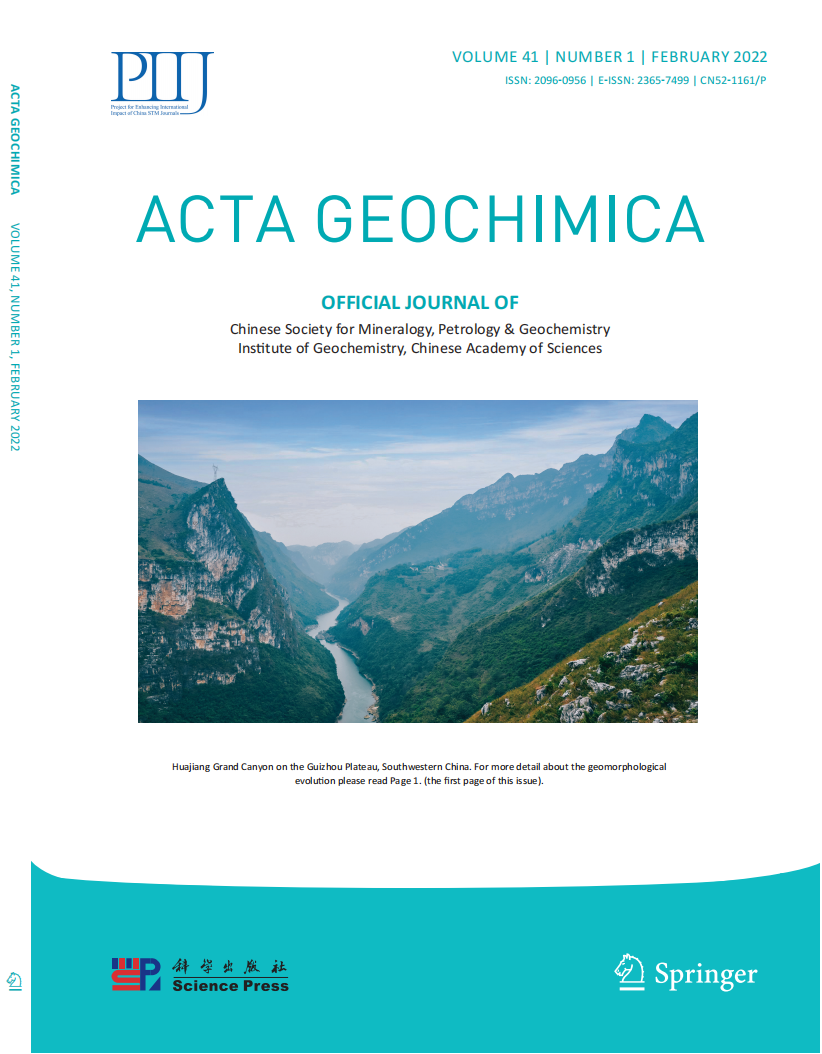- 钛学术文献服务平台 \
- 学术期刊 \
- 基础科学期刊 \
- 化学期刊 \
- 地球化学学报(英文)期刊 \
REE geochemistry of gangue minerals and their geological significance in the Muli antimony ore depos
REE geochemistry of gangue minerals and their geological significance in the Muli antimony ore depos
原文服务方:
地球化学学报(英文)
摘要:
The Muli antimony deposit is located in the Au– Sb polymetallic metallogenic belt in south-eastern Yunnan, China. In this paper, we investigated the concentrations of trace elements in gangue minerals, mainly calcite, quartz, and pyrite, which were formed at different metallogenic stages. Meanwhile, the host rocks, predominantly composed of limestone, are also analysed for comparison. The calcite from the Nadan ore section is enriched with medium-heavy rare earth elements (M-HREEs), likely due to the presence of a high concentration of Fe and Mn impurities, which results in the preferential enrichment of M-HREEs in the calcite. Alternatively, the calcite may be precipitated from the M-HREE-rich granitic leaching fluid. In the Muli ore section, both quartz and pyrite in the metallogenic period show enrichment with light rare earth elements (LREEs), and the wall rock is also enriched with LREEs, which indicates that the wall rock material was involved in the metallogenic process. The W-shaped tetrad effect of quartz in the late metallogenic stage was interpreted to determine extensive fluid–rock interactions in highly fractionated Si-rich systems. Fe and Mn impurities cause M-HREE to be preferentially enriched with calcite to some extent. Whether mineralization is related to granite deserves further study. Eu and Ce anomalies of different types of gangue minerals indicate that the temperature and the fO2 were constantly changing during mineralization, and the temperature of the main ore-stage was higher than 200℃ in an oxidized state. The various REE patterns, LREE/HREE and (La/Yb)N values, reveal that there may be multi-sources and multi-stage hydrothermal activities in the Muli antimony deposit. The REE distribution patterns of minerals are likely interfered with by many internal and external factors. Studies on REE characteristics of calcite, quartz, pyrite and limestone in the Muli antimony deposit have greatly improved the understanding of ore-forming fluids. Whe

推荐文章
Geological significance of nickeliferous minerals in the Fule Pb–Zn deposit, Yunnan Province, China
Nickeliferous
Permian Emeishan basalt
Fule Pb–Zn deposit
MVT deposit
Barrier layer
Petrogenesis, geochemistry and geological significance of Paleocene Granite in South Gangdese, Tibet
Petrogenesis
Zircon U–Pb dating
Cuobulaguo granite
South margin of Gangdese
Tibet
Low-temperature alteration of uranium–thorium bearing minerals and its significance in neoformation
Zircon
Thorite
Xenotime
Radioactive minerals
Low-temperature alteration
Wadi El-Reddah
The occurrences and geochemical characteristics of thorium in iron ore in the Bayan Obo deposit, Nor
Thorium
Occurrence state
Distribution law
Geochemical characteristics
Iron ore
Bayan Obo deposit
内容分析
关键词云
关键词热度
相关文献总数
(/次)
(/年)
文献信息
| 篇名 | REE geochemistry of gangue minerals and their geological significance in the Muli antimony ore depos | ||
| 来源期刊 | 地球化学学报(英文) | 学科 | |
| 关键词 | Muli antimony deposit Ore-forming fluids REE Calcite Pyrite Quartz | ||
| 年,卷(期) | 2019,(6) | 所属期刊栏目 | |
| 研究方向 | 页码范围 | 848-862 | |
| 页数 | 14页 | 分类号 | |
| 字数 | 语种 | 英文 | |
| DOI | 10.1007/s11631-019-00352-y | ||
五维指标
版权信息
全文
- 全文.pdf
引文网络
引文网络
二级参考文献 (0)
共引文献 (0)
参考文献 (0)
节点文献
引证文献 (0)
同被引文献 (0)
二级引证文献 (0)
2022(0)
- 参考文献(0)
- 二级参考文献(0)
- 引证文献(0)
- 二级引证文献(0)
研究主题发展历程
节点文献
Muli antimony deposit
Ore-forming fluids
REE
Calcite
Pyrite
Quartz
研究起点
研究来源
研究分支
研究去脉
引文网络交叉学科
相关学者/机构
期刊影响力
地球化学学报(英文)
主办单位:
中国科学院地球化学研究所
出版周期:
双月刊
ISSN:
2096-0956
CN:
52-1161/P
开本:
大16开
出版地:
贵州省贵阳市观水路46号地球化学研究所
邮发代号:
创刊时间:
1982-01-03
语种:
英文
出版文献量(篇)
294
总下载数(次)
0
期刊文献
相关文献
推荐文献

 免费查重
免费查重










